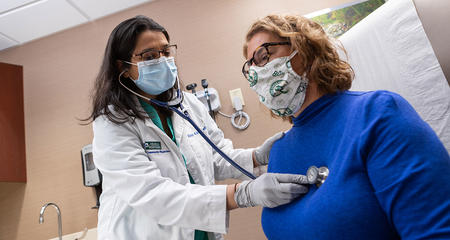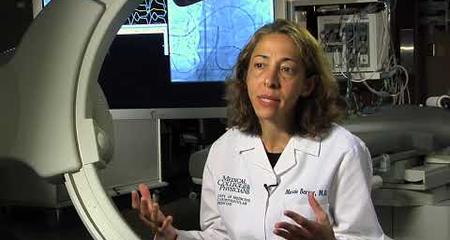Catheter ablation, or radiofrequency ablation, can alleviate many common rhythm problems including paroxysmal supraventricular tachycardia (PSVT), atrial fibrillation (A-fib or AF) and ventricular tachycardia. Catheter ablation has a success rate of more than 90 percent depending on which arrhythmia is being targeted, but some people may need to have the procedure again or other treatments for heart arrhythmias.
Catheter ablation uses either high (radiofrequency) energy or freezing (cryo) energy to eliminate the source of an irregular heart rhythm. In the procedure, an electrophysiologist guides a catheter with an electrode at its tip to the area of heart muscle determined to be the source of the abnormal rhythm. With radiofrequency energy, the electrode supplies a burst of radiofrequency energy to the source to destroy it. With cryo energy, either a catheter or an inflatable balloon delivers freezing energy to destroy the abnormal heart tissue. Learn more about cryoballoon ablation.
3-D Mapping Helps Pinpoint the Source
How do electrocardiologists identify the source of irregular heartbeats? Froedtert & the Medical College of Wisconsin arrhythmia specialists use a sophisticated technique called three-dimensional (3-D) computerized electro-anatomical mapping. This approach allows them to visualize the heart and sources of the irregular beat.
Physicians use one computerized device, called either Carto™ or Ensite™, to create the 3-D images of the heart and arrhythmias. Another device — CartoSound™ — integrates the images with intracardiac ultrasound (ICE). Other heart imaging techniques like cardiac CT and cardiac MRI are also utilized to provide the most accurate views of the heart possible. These tools help minimize your radiation exposure during these procedures.
Your team will give you instructions to prepare for your catheter ablation procedure. In most cases, you will not be able to eat or drink anything after midnight. Ask about whether you should continue to take any medications.
About the Catheter Ablation Procedure
Catheter ablation is an interventional procedure that lasts from two to six hours. You will be sedated and the puncture area is numbed with a local anesthetic. Then, the electrophysiologist will make a small needle puncture in the arm, leg or groin and guide a thin wire and a small catheter to the heart through blood vessels.
After the catheter is correctly placed, electrodes at the end of it are used to stimulate the heart and locate the problem areas that are causing the abnormal heartbeat. The electrophysiologist will use mild energy to destroy or “ablate” the problem area. Once the tissue is destroyed, the abnormal electrical signals that created the arrhythmia can no longer be sent.
Some people can go home on the same day as the ablation, but others will stay in the hospital for one or more nights. Recovery from catheter ablation is usually fairly easy. Your care team will give you detailed instructions regarding activity, exercise, diet and follow-up appointments. You can usually go back to work in a day or two as long as your job doesn't require any heavy lifting. Your doctor may want you to remain on medications to help control your heartbeat.
Virtual Visits Are Available
Safe and convenient virtual visits by video let you get the care you need via a mobile device, tablet or computer wherever you are. We'll assess your condition and develop a treatment plan right away. To schedule a virtual visit, call 414-777-7700.
More to Explore





